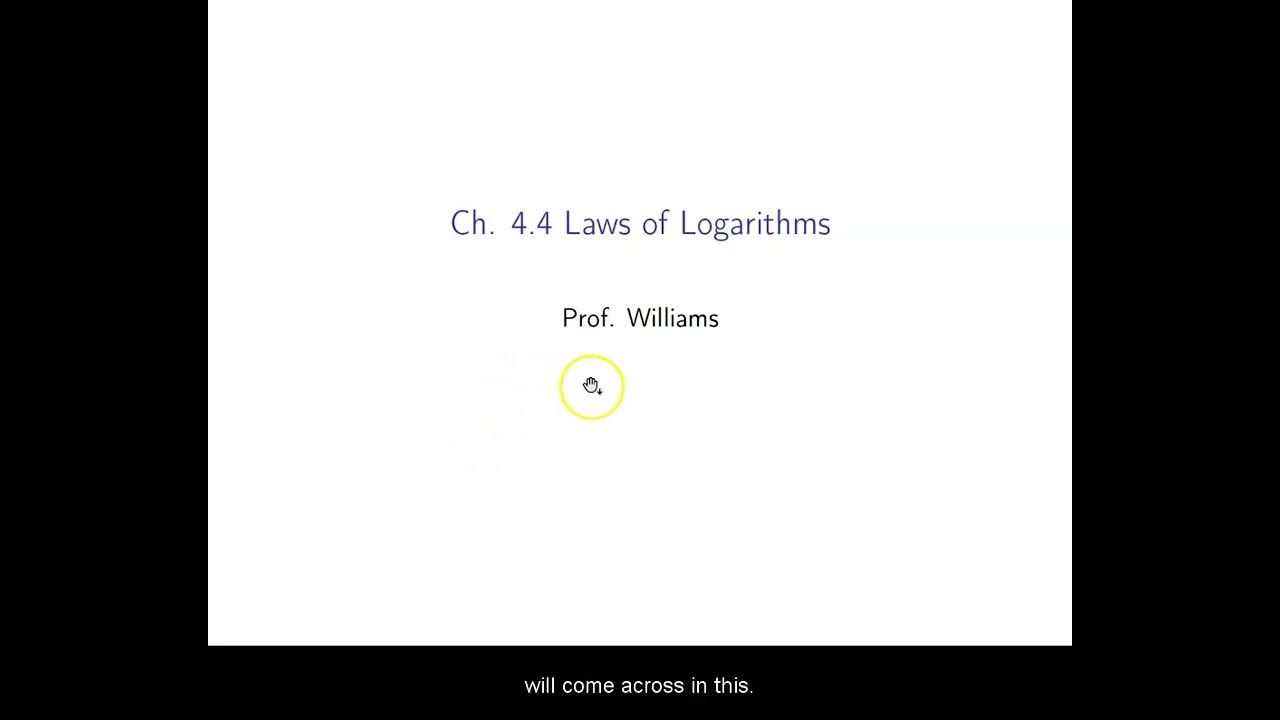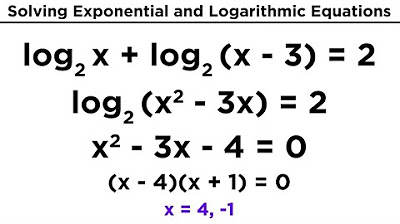How to Combine Logarithms (Precalculus - College Algebra 60)
TLDRThe video script offers an in-depth exploration of combining logarithms, a crucial skill for solving equations involving logarithms. It emphasizes the importance of first moving coefficients as exponents and then combining logarithms with the same base through addition or subtraction. The process involves creating a single logarithm with a product or quotient in the argument, depending on whether the logarithms are added or subtracted. The script provides step-by-step examples, illustrating how to simplify expressions by factoring and rationalizing when necessary. It also highlights the use of the change of base formula in future discussions. The comprehensive approach ensures a solid understanding of the material, preparing viewers for more complex logarithmic operations and problem-solving.
Takeaways
- 📚 **Combining Logarithms**: When two logarithms with the same base are added or subtracted, they can be combined into a single logarithm with a product or quotient in the argument.
- 🔢 **Coefficients as Exponents**: Any coefficient in front of a logarithm can be moved inside as an exponent.
- 🧮 **Subtraction Creates Quotients**: When subtracting two logarithms with the same base, the result is a single logarithm with the arguments in the form of a quotient.
- 📈 **Addition Creates Products**: When adding two logarithms with the same base, the result is a single logarithm with the arguments in the form of a product.
- ➗ **Simplifying Logarithms**: After combining logarithms, it is crucial to simplify the expression, which often involves factoring and reducing complex fractions.
- 🎓 **Change of Base Formula**: The script hints at the upcoming topic of the change of base formula, where logarithms with different bases can be related through a ratio.
- 📉 **Negative Coefficients**: When dealing with logarithms that have negative coefficients, they can be moved inside the logarithm as positive exponents and the arguments will be in the form of a quotient.
- 🤔 **Rationalizing**: Sometimes, it may be necessary to rationalize the argument of a logarithm, especially when dealing with complex fractions.
- 🔗 **Combining with Multiplication/Division**: When combining logarithms with addition or subtraction, they are connected by multiplication or division, creating a single logarithm with a combined argument.
- 📝 **Complex Fractions**: In the process of combining logarithms, complex fractions may arise, which can be simplified by multiplying by the least common denominator (LCD).
- 🧠 **Understanding the Process**: The key to combining logarithms is understanding how to move coefficients, combine products and quotients, and simplify the resulting expressions.
Q & A
What is the main concept discussed in the video?
-The main concept discussed in the video is the combination of logarithms, which involves taking multiple logarithms with the same base and combining them into a single, more condensed form.
How does the process of combining logarithms differ from expanding logarithms?
-Expanding logarithms involves separating products and quotients, typically starting with the simplest parts, while combining logarithms involves first moving coefficients as exponents, then combining the logarithms with the same base by addition or subtraction, and finally simplifying the result.
What happens when two logarithms with the same base are added together?
-When two logarithms with the same base are added, they can be combined into a single logarithm with a product of their original arguments.
What is the result when two logarithms with the same base are subtracted?
-When two logarithms with the same base are subtracted, the result is a single logarithm with the original arguments in the form of a quotient.
How can a coefficient in front of a logarithm be treated when combining logarithms?
-A coefficient in front of a logarithm can be moved and treated as an exponent of the argument inside the logarithm when combining logarithms.
What is the significance of combining logarithms when solving equations?
-Combining logarithms is significant in solving equations as it simplifies the mathematical expression, making it easier to work with and solve, especially when dealing with complex equations involving logarithms.
How does the process of combining logarithms relate to the change of base formula?
-The process of combining logarithms sets the stage for understanding the change of base formula, as it involves working with logarithms with the same base and manipulating them in a way that is similar to how the change of base formula is applied.
What is the role of simplification in the process of combining logarithms?
-Simplification plays a crucial role in the process of combining logarithms as it helps to reduce complex expressions into more manageable forms, which is essential for further calculations or for solving equations.
Can logarithms with different bases be combined?
-Logarithms with different bases cannot be directly combined. They would typically require a common base before they can be combined using the principles discussed in the video.
What is the role of factoring in the process of combining logarithms?
-Factoring is essential in the process of combining logarithms as it allows for the simplification of the arguments within the logarithms. It is typically done after the logarithms have been combined and any necessary exponents have been moved to their appropriate places.
Outlines
📚 Combining Logarithms with the Same Base
This paragraph introduces the concept of combining logarithms with the same base. It explains how to transform expressions involving the addition or subtraction of logarithms, or logarithms with coefficients, into a more condensed form. The key points are that the addition of two logarithms results in a product within a single logarithm, subtraction leads to a quotient, and coefficients can be moved as exponents. The process is essential for solving equations with logarithms and is illustrated with an example involving logarithms of base 3.
🔍 Simplifying Logarithmic Expressions
The second paragraph delves into the simplification of logarithmic expressions. It emphasizes the importance of moving coefficients to exponents and then combining logarithms with the same base that are added or subtracted. The example provided demonstrates how to deal with a subtraction of logarithms, resulting in a quotient within a single logarithm. The paragraph also touches on the potential to express the result as a radical and discusses rationalization, although it notes that this step may not always be necessary.
🧩 Combining Logarithms: Multiplication and Division
This paragraph focuses on the combination of logarithms through multiplication and division, creating a single logarithm from multiple logarithms with the same base. It details the process of moving coefficients to exponents and then combining the logarithms by creating factors in the numerator for additions and in the denominator for subtractions. The paragraph also discusses the simplification of complex fractions and the use of the LCD (Least Common Denominator) to simplify expressions, using an example with logarithms of base 4.
📝 Techniques for Simplifying Complex Logarithmic Expressions
The fourth paragraph discusses advanced techniques for simplifying complex logarithmic expressions. It covers the process of combining logarithms with coefficients, emphasizing the need to move coefficients to exponents before combining. The paragraph also addresses the simplification of expressions involving cube roots and the importance of maintaining the goal of a single logarithm. It provides an example of combining logarithms with base 3, highlighting the option to simplify certain parts of the expression for clarity.
🌐 Factoring and Simplifying Combined Logarithms
This paragraph explains the final steps in combining logarithms, which involve factoring and simplifying the resulting expressions. It stresses the importance of creating a single fraction from all the factors and then simplifying. The paragraph also discusses the use of radicals in logarithmic expressions and provides an example of how to simplify a complex logarithmic expression involving multiple terms and roots.
🔧 Advanced Combining and Simplifying of Logarithms
The final paragraph presents an advanced example of combining and simplifying logarithms. It demonstrates how to handle multiple coefficients and how to organize factors in the numerator for additions and in the denominator for subtractions. The paragraph also covers the simplification of the expression, including the conversion of certain factors into radicals for a cleaner representation. It concludes by emphasizing the utility of these techniques for solving logarithmic equations, both with common bases and in calculus.
Mindmap
Keywords
💡Logarithms
💡Combining Logarithms
💡Coefficients
💡Base of a Logarithm
💡Exponents
💡Simplification
💡Change of Base Formula
💡Rationalizing
💡Factoring
💡Complex Fractions
💡Least Common Denominator (LCD)
Highlights
Logarithms can be combined by following specific rules when they have the same base and are added or subtracted.
Coefficients in front of logarithms can be moved as exponents within the logarithm.
When combining logarithms, subtraction results in a quotient inside a single logarithm, not two separate logarithms.
The process of combining logarithms is crucial for solving equations with logarithms.
Combining logarithms involves moving coefficients as exponents first, then combining logarithms with the same base.
The order of operations for combining logarithms is to first address coefficients, then handle addition or subtraction, and finally simplify.
Simplification often involves changing subtraction of logarithms into a division within a single logarithm.
Combining logarithms can sometimes result in a negative exponent, which can be moved to the denominator.
The quotient resulting from combined logarithms can be expressed as a radical, depending on the context.
Rationalizing a logarithm involves adjusting the power to match the root in the denominator.
Combining logarithms with the same base involves creating a single logarithm with a product or quotient in the argument based on addition or subtraction.
When combining logarithms, positive terms contribute to the numerator, while negative terms contribute to the denominator.
Factoring and simplification are essential steps after combining logarithms to ensure the expression is in its simplest form.
The process of combining logarithms is the reverse of expanding logarithms, where factoring comes last.
Combining logarithms can simplify complex expressions and make them easier to solve in equations.
The technique for combining logarithms can be applied to both natural logarithms and logarithms with other bases.
When combining logarithms, it's important to group terms correctly as products or quotients depending on whether they are added or subtracted.
Combining logarithms is a valuable skill for advanced mathematics, including calculus, where logarithms are frequently used.
Transcripts
Browse More Related Video

How to Expand Logarithms (Precalculus - College Algebra 59)

How to Change the Base of a Logarithm (Precalculus - College Algebra 61)

Business Calculus -- Math 1329 -- Section 4.2 -- Logarithmic Functions

Ch. 4.4 Laws of Logarithms

Solving Logarithms with Common Bases (Precalculus - College Algebra 62)

Solving Exponential and Logarithmic Equations
5.0 / 5 (0 votes)
Thanks for rating: